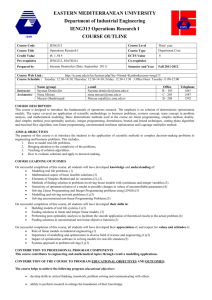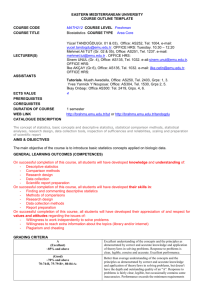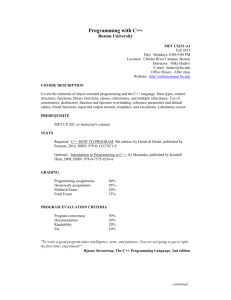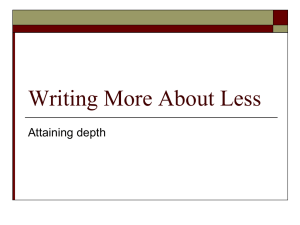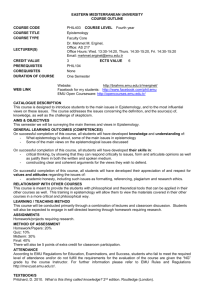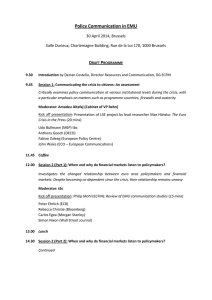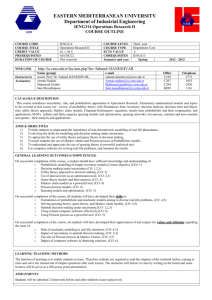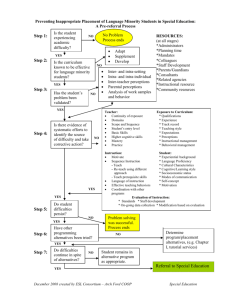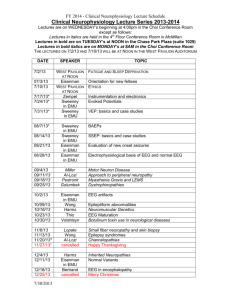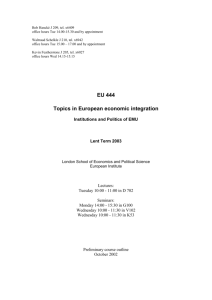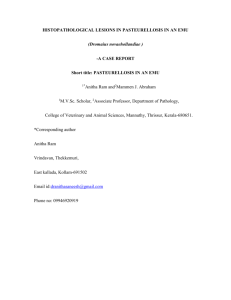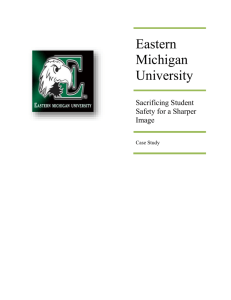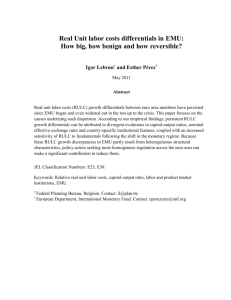Dowload File - Industrial Engineering Department EMU-DAU
advertisement
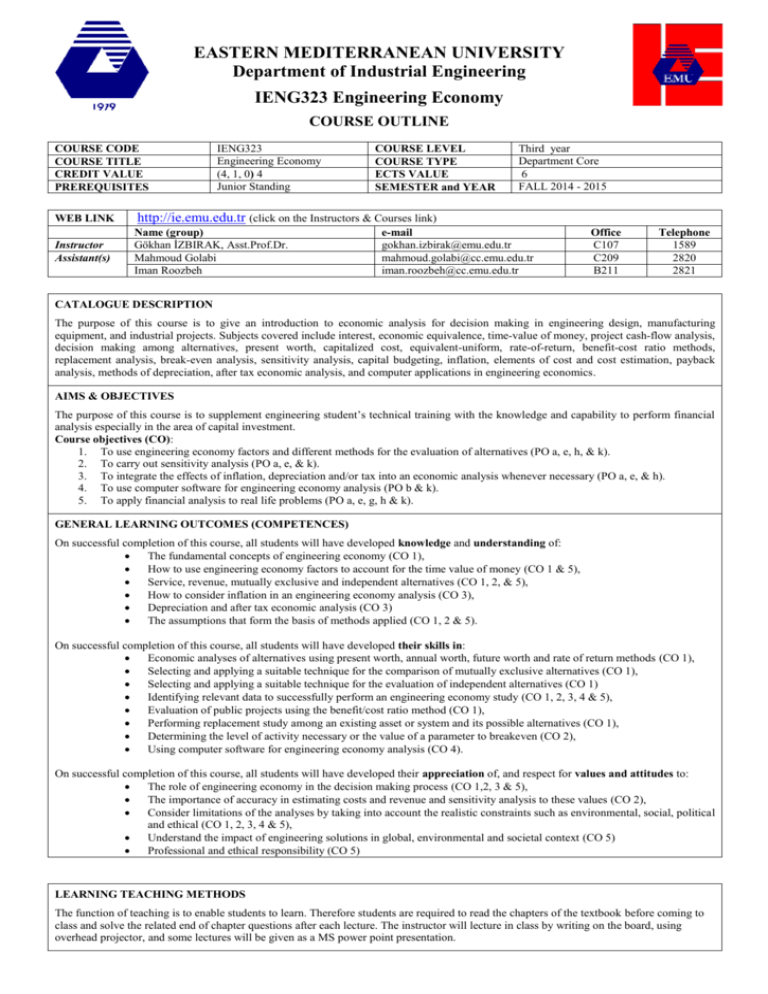
EASTERN MEDITERRANEAN UNIVERSITY Department of Industrial Engineering IENG323 Engineering Economy COURSE OUTLINE COURSE CODE COURSE TITLE CREDIT VALUE PREREQUISITES WEB LINK Instructor Assistant(s) IENG323 Engineering Economy (4, 1, 0) 4 Junior Standing COURSE LEVEL COURSE TYPE ECTS VALUE SEMESTER and YEAR Third year Department Core 6 FALL 2014 - 2015 http://ie.emu.edu.tr (click on the Instructors & Courses link) Name (group) e-mail Gökhan İZBIRAK, Asst.Prof.Dr. gokhan.izbirak@emu.edu.tr Mahmoud Golabi mahmoud.golabi@cc.emu.edu.tr Iman Roozbeh iman.roozbeh@cc.emu.edu.tr Office C107 C209 B211 Telephone 1589 2820 2821 CATALOGUE DESCRIPTION The purpose of this course is to give an introduction to economic analysis for decision making in engineering design, manufacturing equipment, and industrial projects. Subjects covered include interest, economic equivalence, time-value of money, project cash-flow analysis, decision making among alternatives, present worth, capitalized cost, equivalent-uniform, rate-of-return, benefit-cost ratio methods, replacement analysis, break-even analysis, sensitivity analysis, capital budgeting, inflation, elements of cost and cost estimation, payback analysis, methods of depreciation, after tax economic analysis, and computer applications in engineering economics. AIMS & OBJECTIVES The purpose of this course is to supplement engineering student’s technical training with the knowledge and capability to perform financial analysis especially in the area of capital investment. Course objectives (CO): 1. To use engineering economy factors and different methods for the evaluation of alternatives (PO a, e, h, & k). 2. To carry out sensitivity analysis (PO a, e, & k). 3. To integrate the effects of inflation, depreciation and/or tax into an economic analysis whenever necessary (PO a, e, & h). 4. To use computer software for engineering economy analysis (PO b & k). 5. To apply financial analysis to real life problems (PO a, e, g, h & k). GENERAL LEARNING OUTCOMES (COMPETENCES) On successful completion of this course, all students will have developed knowledge and understanding of: The fundamental concepts of engineering economy (CO 1), How to use engineering economy factors to account for the time value of money (CO 1 & 5), Service, revenue, mutually exclusive and independent alternatives (CO 1, 2, & 5), How to consider inflation in an engineering economy analysis (CO 3), Depreciation and after tax economic analysis (CO 3) The assumptions that form the basis of methods applied (CO 1, 2 & 5). On successful completion of this course, all students will have developed their skills in: Economic analyses of alternatives using present worth, annual worth, future worth and rate of return methods (CO 1), Selecting and applying a suitable technique for the comparison of mutually exclusive alternatives (CO 1), Selecting and applying a suitable technique for the evaluation of independent alternatives (CO 1) Identifying relevant data to successfully perform an engineering economy study (CO 1, 2, 3, 4 & 5), Evaluation of public projects using the benefit/cost ratio method (CO 1), Performing replacement study among an existing asset or system and its possible alternatives (CO 1), Determining the level of activity necessary or the value of a parameter to breakeven (CO 2), Using computer software for engineering economy analysis (CO 4). On successful completion of this course, all students will have developed their appreciation of, and respect for values and attitudes to: The role of engineering economy in the decision making process (CO 1,2, 3 & 5), The importance of accuracy in estimating costs and revenue and sensitivity analysis to these values (CO 2), Consider limitations of the analyses by taking into account the realistic constraints such as environmental, social, political and ethical (CO 1, 2, 3, 4 & 5), Understand the impact of engineering solutions in global, environmental and societal context (CO 5) Professional and ethical responsibility (CO 5) LEARNING TEACHING METHODS The function of teaching is to enable students to learn. Therefore students are required to read the chapters of the textbook before coming to class and solve the related end of chapter questions after each lecture. The instructor will lecture in class by writing on the board, using overhead projector, and some lectures will be given as a MS power point presentation. ASSIGNMENTS Students will be given a term project; the project should be prepared according to the project guidelines (which can be found under the following web site http://ie.emu.edu.tr/reportw/?sub=CO. Each report must contain at least Title Page, Table of Contents, List of Tables, List of Figures, List of Symbols/Abbreviations, Main Body of the Text, References, and Appendices. The term project must be handed in latest on January 15, 2015 Thursday before 5:00 pm to the course instructor, or department secretary. Project presentations will take place on January 16, 2015 Friday. Late submissions will be penalized by 50 percent per day. METHOD OF ASSESSMENT All Examinations will be based on lectures, discussions, textbook and assigned work. To enter a formal examination, a student has to present her/his EMU student Identification card to the invigilator. Quizzes: There will be three quizzes designed to test familiarity and basic understanding of various topics. There will be no quiz make-ups. Midterm Exam: The midterm exam will be held in the week designated by the university administration. It will cover all of the material up to the date of examination. Final Exam: The final exam will cover the whole course material. In form it will be a longer version of the midterm exam. Make-up Exams: Make-up examinations will only be offered to students who provided adequate documentation for the reason of their absence within four working days at the latest after the examination date. University regulations apply for graduation make-ups. Any objection to the grade or mark should be made latest within a week following its announcement. Grading Policy: Participation Quizzes Midterm Exam Term Project Final Exam 5% 10 % (5 % each – lowest quiz will be dropped) 25 % 25 % 35 % Note that the instructor reserves the right to modify these percentages in case it is found necessary. You will be informed from the changes, if any. ATTENDANCE & NG Grade Attendance will be taken every lecture hour. Note that university regulations allow instructors to give a grade of NG (Nil Grade) to a student whose absenteeism is more than 30% of the lecture/lab hours and/or who do not complete sufficient work that are included in the assessment of the course. TEXTBOOK/S Leland T. Blank, Anthony J. Tarquin “Engineering Economy” 7th edition, McGraw-Hill International Edition, 2011. References: William G.Sullivan, Elin M. Wicks and James T. Luxhoj “Engineering Economy” 14th edn, Prentice Hall, 2009 Chan S. Park, “Fundamentals of Engineering Economy” 2nd edn, Prentice Hall, 2009 Joseph C. Hartman, “Engineering Economy and the Decision Making Process” Prentice Hall, 2007 Class Schedule Tutorial Schedule 4 hours of lecture per week by the instructor 1 hour of tutorial every two weeks by the course assistants Laboratory Schedule 1 hour of lab every two weeks (lab dates will be announced) COURSE CONTENT AND SCHEDULE Tuesday Thursday Friday Office Hour Week Lecture Hall IE-D203 IE-D203 IE-D203 Fridays Time 14:30-16:20 14:30-16:20 08:30-09:20 (Tutorial) 09:30-10:20 Topics 1 Foundations of engineering economy; Factors: how time and interest affect money 2 Combining factors; Nominal and effective interest rates 3 Present-worth and capitalized cost evaluations 4 Equivalent-annual worth analysis 5 Rate of return analysis of single alternative 6-7 Rate of return evaluations for multiple alternatives 8-9 MIDTERM Exam 10 Benefit cost analysis and public sector economics 11 Replacement analysis 12 Replacement analysis / Breakeven analysis / Sensitivity analysis 13 Effects of inflation 14 Methods of depreciation 15 Basic taxation and after tax economic analysis 16 - 18 Final Exams Presentation Term project presentations (as a group) at the end of the semester Contribution of the Course to meeting the requirements of Criterion 5 Mathematics and Basic Sciences Engineering Science Engineering Design General Education : : 100 % : : - Relationship of Course to Program Outcomes Program Outcomes Level of Satisfaction of the Program Outcomes : Not (a) an ability to apply knowledge of mathematics, science and engineering (b) an ability to design and conduct experiments, as well as to analyze and interpret data (c) an ability to design a system, component, or process to meet desired needs within realistic constraints such as economic, environmental, social, political, ethical, health and safety, manufacturability, and sustainability (d) an ability to function on multi-disciplinary teams (e) an ability to identify, formulate, and solve engineering problems Applicable : Low Level (f) an understanding of professional and ethical responsibility of Satisfaction : High Level (g) an ability to communicate effectively of Satisfaction (h) the broad education necessary to understand the impact of engineering solutions in a global, economic, environmental, and societal context (j) a knowledge of contemporary issues (k) an ability to use the techniques, skills, and modern engineering tools necessary for engineering practice (i) a recognition of the need for, and an ability to engage in life-long learning ACADEMIC HONESTY - PLAGIARISM Cheating is copying from others or providing information, written or oral, to others. Plagiarism is copying without acknowledgement from other people’s work. According to university by laws cheating and plagiarism are serious offences punishable with disciplinary action ranging from simple failure from the exam or project, to more serious action (letter of official warning suspension from the university for up to one semester). Disciplinary action is written in student records and may appear in student transcripts. PLEASE KEEP THIS COURSE OUTLINE FOR FUTURE REFERENCE AS IT CONTAINS IMPORTANT INFORMATION
